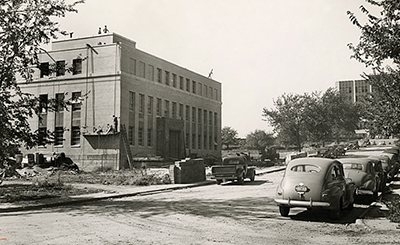
Last month’s installment of Decade by Decade recounted how a federal court in 1944 ruled Harry Steenbock’s patents were invalid.1 The decision made little sense in terms of the actual science of vitamin D and can only be understood within the context of a larger political struggle over federal regulation of food and drugs. That struggle included years of litigation and even a public accusation by opposing counsel that WARF colluded with Nazi sympathizers. In the end, WARF and its opponents reached a truce and the most lasting effect of the 1940s would be how the rapid wartime expansion of the federal bureaucracy forced the young foundation to adapt and modernize.
Tensions between WARF and the federal government gradually emerged over a number of years. Through the 1920s and 1930s, WARF had controlled the health and safety of irradiated vitamin D by cooperating with the American Medical Association and negotiating with private companies. Federal bureaucrats became more involved in 1939 with the creation of the Federal Security Agency (FSA), a cabinet-level office that exercised more active oversight of WARF-licensed products like vitamin D-enriched milk and oatmeal. Although WARF officials viewed the new regulations as excessive, they first tried to influence rather than fight them.
The situation turned confrontational at the end of 1942 when the assistant attorney general sent a letter summoning WARF President George Haight to Washington, D.C. A district judge had just ruled that a rival company could not use irradiated vitamin D without a WARF license. The case would soon be appealed and unless Haight wanted the Justice Department’s Antitrust Division joining the appeal against WARF, he would have to come to Washington and answer a detailed, three-page list of antitrust complaints.
But before WARF’s trustees could implement an adequate response, a change in personnel led to more aggressive tactics from the government. In the middle of 1943, Wendell Berge took over as head of the Antitrust Division. While his predecessors relied more on behind-the-scenes legal tactics, Berge preferred public appeals to American patriotism. He used the language of open markets and democracy to warn that corporate greed could interfere with the global struggle against fascism. Worse still, according to Berge’s book Cartels: Challenge to a Free World, international collusion among companies had aided the enemy by limiting the supply of much needed raw materials such as rubber, metal, medicines…and vitamin D.2 The supposed WARF monopoly took up an entire chapter.
Over the course of a few months, WARF officials went from negotiating behind closed doors to having their loyalty questioned in public. Testifying before a Senate subcommittee in October 1943, Berge called WARF a “screen behind which a group of monopolistic chemical, pharmaceutical, and food companies control vitamin D.” That inflammatory rhetoric arose from a basic misunderstanding. The scope of WARF’s patents could in no way monopolize vitamin D, a natural substance obtained from sitting in the sun or eating oily fish. In fact, by the 1940s, consumers could even purchase synthetic forms of vitamin D that had no connection to Steenbock’s process.3
Nonetheless, the foundation had filed for German patents and issued a license to the German conglomerate I.G. Farben. During a war with the Nazis, those relationships proved too tempting a target for Berge’s grandstanding.
This national attention forced WARF officials to undertake a careful, long-term strategy that revealed just how far the foundation had come since 1925. In the early years, Steenbock called WARF an “experiment,” by which he meant an outward-facing organization built to explore new financial opportunities and scientific endeavors.4 But that sort of improvisation became a liability in the face of a crusading Justice Department looking to pounce on inconsistent business practices.
Consequently, WARF leadership chose to avoid competing with Berge in the public arena and focused instead on pressing their case in court. They knew that no one could match Steenbock and his team when it came to understanding their patents, even if their depth of scientific knowledge took hours of depositions to explain and defend. They wagered that the hard-earned expertise of WARF personnel would win out.
From the start, the Ninth Circuit Court of Appeals proved sympathetic to WARF’s opponents and invalidated the Steenbock patents. In response, citing “serious errors committed by the Court,” WARF filed for a rehearing. The petition led to a new ruling but the same result. When the Supreme Court declined to hear the case, the WARF team filed new lawsuits in different jurisdictions. They aimed to fight their way to another appeal, which would force the Supreme Court to take up the case.
Among district rulings, circuit appeals, retractions and concurrences, a multitude of conflicting legal justifications written by judges with a minimal understanding of the science began to pile up.5
Finally, in 1946 the government offered a truce. In legal terms, they proposed a consent decree. The foundation would admit no wrongdoing and dedicate the patents to the public, and all litigation would be dropped. In short, the patents would remain valid but would no longer be enforced or contested.
In a press release announcing the settlement, President Haight assured the public that the end of the Steenbock patents did not mean “the discontinuance of the Foundation’s operations.” In fact, he announced, WARF would soon construct new buildings to house their offices and “a modern and well equipped laboratory.” What had begun as an informal gathering of alumni now had a staff of more than 100 people and, for the first time, a true brick-and-mortar foundation.6
To find out what the future held for the Wisconsin Alumni Research Foundation, stay tuned for the fourth installment of our Decade by Decade series.
Kevin Walters
Historian-in-Residence
2015